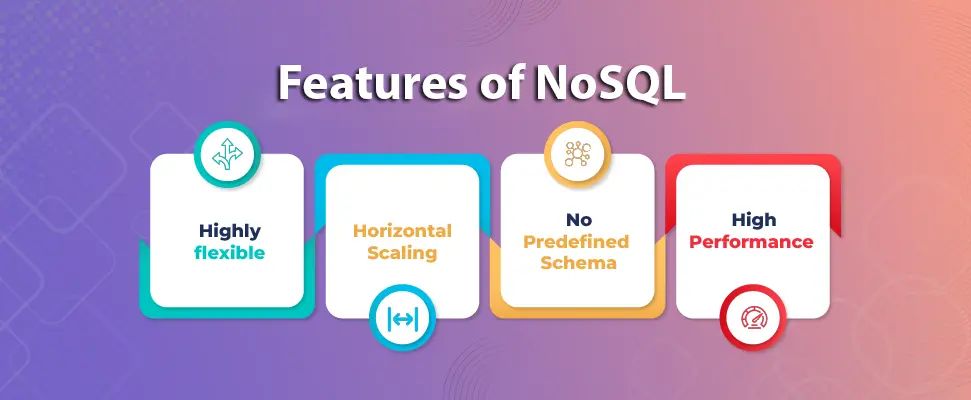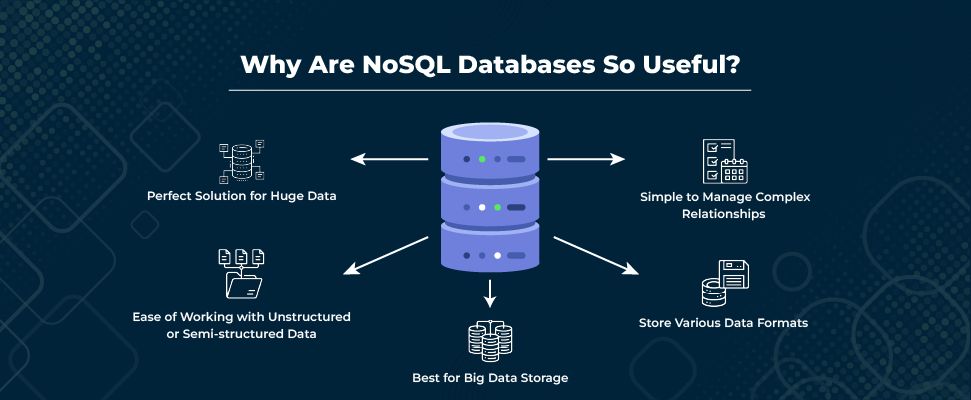Table of Contents
ToggleIntroduction
NoSQL databases are a convenient option for storing and managing extensive, unstructured data. Although MySQL, Oracle, and SQL Server have been preferred for maintaining data integrity and fast querying, with the rise of big data, NoSQL databases stole the spotlight and became increasingly popular among developers. It is well-known for its high-performance and scalability databases. This blog will explore why NoSQL databases are so useful.
NoSQL Database in Brief
NoSQL is a type of database management system that differs from traditional relational databases like SQL. It came to fame in the late 2000s with the best storage capacity at a minimum cost. Since storage costs decreased rapidly, the amount of data that applications needed to store and query increased. This data came in different shapes and sizes, it was impossible for a traditional relational database to define the schema and store it. Therefore, the solution for this is NoSQL, which stores huge amounts of unstructured data.
NoSQL can be document-based, key-value pairs, wide-column stores, or graph databases. Due to this, it can effectively handle unstructured or semi-structured data. It has high scalability and performance extremely well at a massive scale, making them a suitable for modern applications. Whereas relational databases store structured data tables and relationships between their variables and entities with predefined schemas, NoSQL databases have a flexible schema. Some of the renowned NoSQL database examples are MongoDB, Cosmos DB, MemeCached, and Oracale NoSQL.

Don't miss out on your chance to work with the best
apply for top global job opportunities today!
Features of NoSQL

- Highly flexible: NoSQL database’s high flexibility makes it perfect for handling dynamic data. Due to this, it can seamlessly manage a diverse range of data, such as JSON, XML, key-value pairs, and more.
- Horizontal Scaling: This feature lets developers add more servers and distribute the data. It is also beneficial for handling large loads. Thus, it can be used in web applications with different workloads.
- No Predefined Schema: The most traditional relational databases have predefined schema definitions. Whereas, NoSQL databases are schema-less, which gives them the upper hand to deal with evolving data models.
- High Performance: NoSQL databases are designed to optimize high performance; therefore, they can easily manage and handle massive volumes of data.
Must Read: WHAT ARE THE VARIOUS TYPES OF DATABASES?
Types of NoSQL Databases
NoSQL databases without a predefined schema can effectively handle unstructured, semi-structured, and structured data. In recent years, it has gained a lot of traction due to its scalability, flexibility, and high availability. The following are different types of NoSQL databases; let’s have a look at the following list of NoSQL databases:

Document-based databases
Just as the name suggests, this type of database stores data in the form of a document. No tables with rows and columns are required. This database can be in the JSON format or the BSON format, which enables them to store nested data structurally. A document-based database is best for social media content and user-generated content, where the structure of the data changes over time. It supports nested arrays and objects that allow them to store hierarchical structures without normalizing them into multiple tables. However, if one document fails during an operation, there is a high chance that it will leave other documents in an inconsistent state. Also, it has limited support for joins between collections and documents, which can add overhead and complexity to the application layer.
Key-value stores
As the name implies, this type of database stores the data in the form of key-value pairs, where keys are unique identifiers and strings can be complex objects or strings. It is best for performing quick read-and-write operations. Plus, it allows you to add more nodes to a cluster without any downtime. Apart from this, this type of database supports atomic operations on individual keys, which guarantees consistency across multiple clients accessing the same set of keys. Since key-value pairs do not support predefined schemas and indexes, they cannot carry out the task that requires complex queries.
Column-family stores
This type of database is similar to a traditional relational database. The only difference is that it stores data in columns, not in rows. It is extremely beneficial when working with semi-structured or structured data that requires fast read-and-write operations. This kind of database lets users perform complex queries on the database. Besides that, handling large data sets is on the fly, and users can store data in a distributed environment. Like other databases, it also lacks support for joins. It does not support transactions across multiple columns, which makes it hard to ensure consistency across different sets in the database system.
Graph database
This type of database is perfect for handling a dataset with complex relationships between different entities, like social networks and supply chain systems. It uses mathematical graph theory and stores data and their relationships using nodes and edges. Although traditional relational databases can handle complex queries, this kind of task makes the process slow and cumbersome. This is where the graph database turns out to be beneficial. It allows you to execute complicated database queries at high speed. Unlike relational databases, it has a different operating principle. However, as the node grows more querying and maintaining a database will be more challenging. Therefore, these are the four NoSQL database lists that provide convenient options for storing and managing extensive unstructured data.
Also Read: 12 DATABASE EXAMPLES IN REAL LIFE
Why Are NoSQL Databases So Useful?

NoSQL databases are extremely beneficial when handling large sets of distributed data. Since they’re schema-less, non-tabular, and store way differently than relational tables, this database is classified according to the data model, such as document, graph, column, and key-value. At its core, NoSQL provides a mechanism for storing and retrieving information. The following are the reasons why NoSQL databases are so useful today:
Perfect Solution for Huge Data
NoSQL databases can spread across multiple servers and efficiently handle large amounts of rapidly growing data. Developers don’t have to manage enough resources to scale vertically; instead, they have the flexibility to design a database system to get the most insights from their data. Besides, NoSQL data is also perfect for real-time data processing. Its high speed makes it suitable for IoT, gaming, and fraud detection.
Ease of Working with Unstructured or Semi-Structured Data
NoSQL databases are the best approach to working with unstructured or semi-structured data that is always changing. It is built on a flexible data schema that greatly speeds up the development process while minimizing database management efforts. This flexibility of NoSQL allows the data model to rapidly change and update the application. Modern-day application development is fast, and iterations are quick, so removing the task of updating schemas constantly saves you valuable time that can be spent on even faster development.
Best for Big Data Storage
The NoSQL database’s high scalability contributes to its usage for big data storage. A traditional database can only work on a single server, but a NoSQL database with horizontal scaling can work on multiple servers. Hence, traditional databases have a lot of performance issues; on the contrary, NoSQL data doesn’t have any performance issues. Due to this, it is an ideal choice for applications that require large volumes of data to store and process, such as social media platforms and e-commerce sites. Not to mention that this high scalability can also be advantageous for businesses to easily adapt their database infrastructure to their needs over time.
Simple to Manage Complex Relationships
In traditional database management, using relationships like parent-child or many-to-many relationships, we can relate different tables that are somehow interconnected. In this traditional approach, querying requires hopping from one table to another, and to join the data, it needs resource-intensive join operations. Whereas, a NoSQL database can efficiently handle highly connected data using the graph database. Therefore, this makes it the best choice for social networks, recommendation engines, fraud detection, or any application that needs to traverse through interconnected data points.
Store Various Data Formats
NoSQL doesn’t need to define a schema before storing any data. It provides a great degree of flexibility that enables it to store various formats without a predefined schema. This means businesses can use average NoSQL to store any data without worrying about the need for costly and time-consuming schema changes. The best part is that with automatic failover and replication, it can tolerate outages, any hardware failures, and maintenance window downtime. Therefore, NoSQL databases have a high level of availability, making them a perfect choice for applications that require uninterrupted access to data, such as online banking platforms or healthcare information systems. Thus, these advantages of NoSQL allow us to handle large sets of distributed data seamlessly.
Must Read: DIFFERENCE BETWEEN SQL VS. NOSQL DATABASE
NoSQL databases: A Go-to Solution and Reliable Data Storage
NoSQL databases offer high flexibility, availability, and scalability, making them ideal for businesses that need to store and process large amounts of data reliably. Traditional relational databases use a fixed schema approach to store any data, whereas NoSQL databases use a different approach to store the data, either unstructured or semi-structured, without predefined table structures. It can handle an enormous amount of unstructured and semi-structured big data with ease. Their database provides flexible storage models, which let users store data in various formats, such as JSON documents, key-value pairs, column-family stores, or graphs. Its distributed architecture allows NoSQL databases to maintain uptime even during hardware failures by replicating and distributing copies across servers. When it comes to handling the massive volume of unstructured and semi-structured big data, the NoSQL database is unparalleled. Today, data plays a crucial role for every business and organization. From data, businesses can gain valuable insights that help them make better decisions and stay ahead of the competition. To store and analyze a vast amount of data in a scalable and efficient way, NoSQL is the go-to solution. If you’re searching for a role in database management, then sign up with Olibr now!
Take control of your career and land your dream job
sign up with us now and start applying for the best opportunities!

FAQs
NoSQL offers a simple approach, whereas SQL requires multiple code changes in a data model. NoSQL databases provide a high degree of flexibility for data modeling, and changes can be made easily without any extensive code alterations.
NoSQL databases are designed in such a way that it can handle large amounts of data efficiently.
Among all the NoSQL databases, MongoDB is the best; it alone holds 45.50 percent of the market share.
Cost-effectiveness, high flexibility, replications, and high speed, due to which it allows to handle enormous amounts of rapidly alternating data.
Some of the NoSQL database lists are Apache HBase, OrientDB, RavenDB, Apache Cassandra, Amazon DynamoDB, and Amazon ElastiCache.

